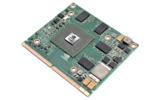NVIDIA GeForce GTX 1050 Ti Max-Q vs NVIDIA Quadro FX 3700M vs NVIDIA Quadro FX 880M
NVIDIA GeForce GTX 1050 Ti Max-Q
► remove from comparison
Die Nvidia GeForce GTX 1050 Ti mit Max-Q Design ist eine Mittelklasse-GPU basierend auf der Pascal-Architektur und wurde im Januar 2018 vorgestellt. Anders als die schnelleren Modelle basiert die GTX 1050 Ti auf dem GP107-Chip, der im 14-nm-Verfahren bei Samsung hergestellt wird.
Im Vergleich zur normalen GTX 1050 Ti gibt es noch weitere Unterschiede als den Takt. Der Treiber wurde auf Effizienz (und nicht Leistung) optimiert (nur für die Max-Q Modelle), optimierte Spannungswandler für 1V Betreib, high-end Kühlungsmethoden und eine 40 dB Grenze für die Lüfterlautstärke (mit Taktanpasssungen um dies jederzeit zu gewährleisten) zeichnen die Max-Q Variante aus.
Features
Der GP107-Chip wird in einem 14-nm-FinFET-Prozess bei Samsung gefertigt und bietet eine Reihe neuer Features, unter anderem Support für DisplayPort 1.4 (ready), HDMI 2.0b, HDR, Simultaneous Multi-Projection (SMP) sowie verbessertes H.265 Video De- und Encoding (PlayReady 3.0). Eine genaue Auflistung der Verbesserungen und Features der neuen Pascal Desktop-GPUs finden Sie in unserem Pascal-Architektur-Artikel.
Performance
Die exakte Performance der GeForce GTX 1050 Ti Max-Q kann sich in Abhängigkeit von der Kühlung des jeweiligen Notebooks stark unterscheiden. Im Optimalfall ist die Leistung etwa 10 bis 15 % unterhalb der normalen GTX 1050 Ti angesiedelt. Dadurch eignet sich die Grafikkarte am besten für Full HD (1920 x 1080) bei hoher aber nicht maximaler Detailstufe.
Leistungsaufnahme
Die Leistungsaufnahme der GeForce GTX 1050 Ti Max-Q ist von Nvidia mit 40 - 46 Watt spezifiziert und damit deutlich unterhalb der normalen Notebook GTX 1050 Ti (64 Watt). Selbst die normale GTX 1050 ist mit 53 Watt höher spezifziert. Damit eignet sich die Grafikkarte auch für dünne und leichte 14-Zoll Notebooks.
NVIDIA Quadro FX 3700M
► remove from comparisonDie Nvidia Quadro FX 3700M ist eine mobile Grafikkarte für Workstation-Laptops. Sie basiert auf die selbe Architektur wie die GeForce 9800M GTX jedoch bietet sie die vollen 128 Shaderprozessoren des G92 Chips (9800M GTX nur 112). Daher ist sie vergleichbar zur GTX 280M, jedoch wird sie noch in 65nm gefertigt und geringer getaktet.
Zur Zeitpunkt der Veröffentlichung war sie die schnellste Quadro Karte für Notebooks. An 1. Dezember 2009 wurde sie jedoch von der Quadro FX 3800M abgelöst (ebenfalls 128 Shader Cores, jedoch bereits in 55nm gerfertigt und daher mit höheren Taktraten).
NVIDIA Quadro FX 880M
► remove from comparison
Die NVIDIA Quadro FX 880M ist eine professionelle Mittelklasse Grafikkarte für mobile Workstations / Laptops. Sie basiert auf die Nvidia GeForce GT 330M mit etwas geringeren Taktraten und beherrscht dadurch DirectX 10.1. Durch ein spezielles BIOS und Treiber zeigt die Quadro FX 880M eine bessere Performance bei professionellen Anwendungen. Weiters ist die Grafikkarte für die gängigsten 3D Anwendungen (DCC, CAD, Modelling) zertifiziert und sollte dadurch fehlerfrei arbeiten. Außerdem bietet der Treiber verschiedene Profile um sich für die professionellen Anwendungen automatisch zu konfigurieren (ähnlich der Spieleprofile in GeForce Grafiktreibern).
Ohne Last taktet die FX 880M nur mit 135 / 270 / 135 MHz (Kern- / Shader- / Speichertakt) wodurch Strom gespart wird (Werte aus dem Lenovo Thinkpad W510).
Wie die GT330M verwendet auch die FX 880M den GT216 Kern. Dieser basiert laut Nvidia auf die High-End Desktop Architektur (GTX 200) und hat daher auch einige Verbesserungen gegenüber der Vorgängergeneration. Weiters wurde die Micro-Architektur verbessert um Akkulaufzeit und Performance zu steigern.
Die Quadro FX 880M unterstützt die Videodekodierung im Grafikchip (PureVideo HD) für weniger CPU Belastung bei HD Dekodierung. Der verbaute Video Processor 4 (VP4) unterstützt das vollständige Dekodieren von H.264, VC-1, MPEG-2, und jetzt auch MPEG-4 ASP (DivX oder xVID). Nur MPEG-1 wird nicht unterstützt (jedoch ist der Decodieraufwand hier minimal).
Wie auch bei der alten 9700M GTS übernehmen 48 so genannte Stream Prozessoren die anstehende Grafikarbeit (die früher die Pixel und Vertex Shader übernommen haben). Der Vorteil ist, daß es theortisch keinen Leerlauf der ALUs mehr gibt. Die Streamprozessoren sind bei NVIDIA 1-dimensional (1D) und können pro Takt eine Skalaroperation mit einer MADD- (Addition und Multiplikation) und MUL-Anweisung (Multiplikation) durführen. Ausserdem taktet NVIDIA die Shader-ALUs höher als den restlichen Chip (1100 versus 500 MHz).
Dank CUDA, DirectX Compute, OpenCL und PhysX Support können die Stream Prozessoren auch für andere Anwendungen (Video Kodierung, Physikeffekte, ...) eingesetzt werden und sind bei solchen Spezialanwendungen deutlich schneller als gängige Hauptprozessoren (durch die hohe Anzahl an Shadern die parallel arbeiten).
Moderne und anspruchsvolle DirectX 10 Spiele (wie Crysis) laufen auf der GT 330M mit mittleren Details bei mittleren Auflösungen flüssig. Da die FX 880M Treiber für professionelle Anwendungen optimiert sind, kann hier die Spieleperformance leiden. Spieler sollten deshalb klar zur GeForce Linie greifen.
Zum automatischen Umschalten auf die integrierte Grafik des Prozessors, unterstützt der Grafikchip Optimus. Dies wurde jedoch z.B. beim W510 nicht verbaut.
| NVIDIA GeForce GTX 1050 Ti Max-Q | NVIDIA Quadro FX 3700M | NVIDIA Quadro FX 880M | ||||||||||||||||||||||||||||||||||||||||||||||||||||||||||||||||||||||||||||||||||||||||||||||||||||||||||||||||||||||||||||||||||||||||||||||||||||||||||||||||||||||||||||
| Quadro FX Serie |
|
|
| |||||||||||||||||||||||||||||||||||||||||||||||||||||||||||||||||||||||||||||||||||||||||||||||||||||||||||||||||||||||||||||||||||||||||||||||||||||||||||||||||||||||||||
| Codename | N17P-G1 Max-Q | NB9E-GLM3 | N10P-GLM | |||||||||||||||||||||||||||||||||||||||||||||||||||||||||||||||||||||||||||||||||||||||||||||||||||||||||||||||||||||||||||||||||||||||||||||||||||||||||||||||||||||||||||
| Architektur | Pascal | G9x | GT2xx | |||||||||||||||||||||||||||||||||||||||||||||||||||||||||||||||||||||||||||||||||||||||||||||||||||||||||||||||||||||||||||||||||||||||||||||||||||||||||||||||||||||||||||
| Pipelines | 768 - unified | 128 - unified | 48 - unified | |||||||||||||||||||||||||||||||||||||||||||||||||||||||||||||||||||||||||||||||||||||||||||||||||||||||||||||||||||||||||||||||||||||||||||||||||||||||||||||||||||||||||||
| Kerntakt | 1151 – 1290 - 1290 – 1417 (Boost) MHz | 550 MHz | 550 MHz | |||||||||||||||||||||||||||||||||||||||||||||||||||||||||||||||||||||||||||||||||||||||||||||||||||||||||||||||||||||||||||||||||||||||||||||||||||||||||||||||||||||||||||
| Speichertakt | 7000 MHz | 800 MHz | 790 MHz | |||||||||||||||||||||||||||||||||||||||||||||||||||||||||||||||||||||||||||||||||||||||||||||||||||||||||||||||||||||||||||||||||||||||||||||||||||||||||||||||||||||||||||
| Speicherbandbreite | 128 Bit | 256 Bit | 128 Bit | |||||||||||||||||||||||||||||||||||||||||||||||||||||||||||||||||||||||||||||||||||||||||||||||||||||||||||||||||||||||||||||||||||||||||||||||||||||||||||||||||||||||||||
| Speichertyp | GDDR5 | GDDR3 | GDDR3, DDR3 | |||||||||||||||||||||||||||||||||||||||||||||||||||||||||||||||||||||||||||||||||||||||||||||||||||||||||||||||||||||||||||||||||||||||||||||||||||||||||||||||||||||||||||
| Max. Speichergröße | 4 GB | 1024 MB | 1024 MB | |||||||||||||||||||||||||||||||||||||||||||||||||||||||||||||||||||||||||||||||||||||||||||||||||||||||||||||||||||||||||||||||||||||||||||||||||||||||||||||||||||||||||||
| Shared Memory | nein | nein | nein | |||||||||||||||||||||||||||||||||||||||||||||||||||||||||||||||||||||||||||||||||||||||||||||||||||||||||||||||||||||||||||||||||||||||||||||||||||||||||||||||||||||||||||
| API | DirectX 12_1, OpenGL 4.5 | DirectX 10, Shader 4.0 | DirectX 10.1, Shader 4.1 | |||||||||||||||||||||||||||||||||||||||||||||||||||||||||||||||||||||||||||||||||||||||||||||||||||||||||||||||||||||||||||||||||||||||||||||||||||||||||||||||||||||||||||
| Stromverbrauch | 40 - 46 Watt | 75 Watt | 35 Watt | |||||||||||||||||||||||||||||||||||||||||||||||||||||||||||||||||||||||||||||||||||||||||||||||||||||||||||||||||||||||||||||||||||||||||||||||||||||||||||||||||||||||||||
| Herstellungsprozess | 16 nm | 65 nm | 40 nm | |||||||||||||||||||||||||||||||||||||||||||||||||||||||||||||||||||||||||||||||||||||||||||||||||||||||||||||||||||||||||||||||||||||||||||||||||||||||||||||||||||||||||||
| Features | Multi-Projection, VR Ready, G-SYNC, Vulkan, Multi Monitor | OpenGL 2.1, CUDA, PowerMizer 8.0 | ||||||||||||||||||||||||||||||||||||||||||||||||||||||||||||||||||||||||||||||||||||||||||||||||||||||||||||||||||||||||||||||||||||||||||||||||||||||||||||||||||||||||||||
| Notebookgröße | mittel (15.4" z.B.) | groß (17" z.B.) | mittel (15.4" z.B.) | |||||||||||||||||||||||||||||||||||||||||||||||||||||||||||||||||||||||||||||||||||||||||||||||||||||||||||||||||||||||||||||||||||||||||||||||||||||||||||||||||||||||||||
| Erscheinungsdatum | 03.01.2018 | 14.08.2008 | 07.01.2010 | |||||||||||||||||||||||||||||||||||||||||||||||||||||||||||||||||||||||||||||||||||||||||||||||||||||||||||||||||||||||||||||||||||||||||||||||||||||||||||||||||||||||||||
| Herstellerseite | www.nvidia.com | www.nvidia.com | www.nvidia.com | |||||||||||||||||||||||||||||||||||||||||||||||||||||||||||||||||||||||||||||||||||||||||||||||||||||||||||||||||||||||||||||||||||||||||||||||||||||||||||||||||||||||||||
| Shadertakt | 1375 MHz | 1210 MHz | ||||||||||||||||||||||||||||||||||||||||||||||||||||||||||||||||||||||||||||||||||||||||||||||||||||||||||||||||||||||||||||||||||||||||||||||||||||||||||||||||||||||||||||
| Transistors | 754 Million |
Benchmarks
3DM Vant. Perf. total + NVIDIA GeForce GTX 1050 Ti Max-Q
specvp11 snx-01 + NVIDIA Quadro FX 880M
Cinebench R15 OpenGL 64 Bit + NVIDIA GeForce GTX 1050 Ti Max-Q
GFXBench T-Rex HD Offscreen C24Z16 + NVIDIA GeForce GTX 1050 Ti Max-Q
Average Benchmarks NVIDIA GeForce GTX 1050 Ti Max-Q → 100% n=5
Average Benchmarks NVIDIA Quadro FX 3700M → 40% n=5
Average Benchmarks NVIDIA Quadro FX 880M → 32% n=5
* Smaller numbers mean a higher performance
1 This benchmark is not used for the average calculation
Spiele-Benchmarks
Die folgenden Benchmarks basieren auf unseren Spieletests mit Testnotebooks. Die Performance dieser Grafikkarte bei den gelisteten Spielen ist abhängig von der verwendeten CPU, Speicherausstattung, Treiber und auch Betriebssystem. Dadurch müssen die untenstehenden Werte nicht repräsentativ sein. Detaillierte Informationen über das verwendete System sehen Sie nach einem Klick auf den fps-Wert.

Dirt Rally 2.0
2019
Anthem
2019
Far Cry New Dawn
2019
Metro Exodus
2019
Just Cause 4
2018
Darksiders III
2018
Battlefield V
2018
Farming Simulator 19
2018
Hitman 2
2018
Forza Horizon 4
2018
F1 2018
2018
Monster Hunter World
2018
The Crew 2
2018
Far Cry 5
2018
X-Plane 11.11
2018
Destiny 2
2017
Team Fortress 2
2017
Rocket League
2017
Prey
2017
For Honor
2017
Farming Simulator 17
2016
Battlefield 1
2016
Civilization VI
2016
Overwatch
2016
The Division
2016
Rainbow Six Siege
2015
World of Warships
2015
Dota 2 Reborn
2015
The Witcher 3
2015
GTA V
2015
BioShock Infinite
2013
Diablo III
2012
Fifa 11
2010
StarCraft 2
2010
CoD Modern Warfare 2
2009Average Gaming NVIDIA GeForce GTX 1050 Ti Max-Q → 100%
Average Gaming 30-70 fps → 100%
Average Gaming NVIDIA Quadro FX 880M → 20%
Average Gaming 30-70 fps → 21%
| NVIDIA GeForce GTX 1050 Ti Max-Q | low | med. | high | ultra | QHD | 4K |
|---|---|---|---|---|---|---|
| Dirt Rally 2.0 | 133.2 | 56.7 | 44.3 | 27.2 | 11.3 | |
| Anthem | 67.1 | 40.5 | 34 | 30.4 | 9 | |
| Far Cry New Dawn | 86 | 49 | 45 | 42 | 29 | 15 |
| Metro Exodus | 58 | 41 | 30 | 24 | 4.7 | |
| Just Cause 4 | 73.2 | 47.9 | 36.1 | 35.3 | 12.9 | |
| Darksiders III | 134.5 | 87.4 | 73.7 | 65 | 13.2 | |
| Battlefield V | 100.1 | 57.3 | 47.9 | 44.8 | 17.3 | |
| Farming Simulator 19 | 193.6 | 128.7 | 80.5 | 61 | 22 | |
| Hitman 2 | 64.8 | 41 | 37.5 | 35.9 | 11.3 | |
| Call of Duty Black Ops 4 | 118.7 | 46.3 | 45 | 37.5 | 10.1 | |
| Assassin´s Creed Odyssey | 67 | 43 | 34 | 18 | 7 | |
| Forza Horizon 4 | 122 | 67 | 61 | 47 | 20 | |
| Shadow of the Tomb Raider | 97 | 39 | 35 | 29 | 11 | |
| F1 2018 | 134 | 80 | 62 | 38 | 17 | |
| Monster Hunter World | 100.3 | 39.2 | 34.9 | 26.8 | 8.3 | |
| The Crew 2 | 60 | 49.1 | 45.3 | 42 | 14 | |
| Far Cry 5 | 86 | 47 | 43 | 39 | 13 | |
| X-Plane 11.11 | 92.7 | 80.3 | 69.4 | 39.5 | ||
| Final Fantasy XV Benchmark | 68 | 37 | 24 | 9.2 | ||
| Star Wars Battlefront 2 | 92.3 | 42 | 34.3 | 30.4 | ||
| Assassin´s Creed Origins | 58 | 41 | 33 | 27 | 13 | |
| Destiny 2 | 119.5 | 69.4 | 64.3 | 57.9 | 18.9 | |
| Middle-earth: Shadow of War | 105 | 55 | 41 | 31 | 13 | |
| Team Fortress 2 | 129.8 | 123.6 | 115.7 | 112.6 | 65.2 | |
| Rocket League | 249.1 | 169.1 | 112.5 | 42.3 | ||
| Prey | 142.4 | 85.6 | 68.3 | 58.9 | 21.7 | |
| Ghost Recon Wildlands | 83 | 43 | 39 | 22 | 14 | |
| For Honor | 146 | 66 | 65 | 50 | 19 | |
| Farming Simulator 17 | 137.3 | 104.6 | ||||
| Battlefield 1 | 122 | 103 | 55 | 51 | 21 | |
| Civilization VI | 112.5 | 85.8 | 51 | 43 | ||
| Overwatch | 285.4 | 233.9 | 117.7 | 70.5 | 37 | |
| Ashes of the Singularity | 63 | 41.3 | 35.8 | 15.7 | ||
| The Division | 126 | 86 | 42 | 34 | 15 | |
| Rise of the Tomb Raider | 125 | 77 | 45 | 38 | 17 | |
| Rainbow Six Siege | 250 | 158 | 91 | 65 | 29 | |
| World of Warships | 168.6 | 143.9 | 112.7 | 101 | 34.4 | |
| Dota 2 Reborn | 111.9 | 104.2 | 98.1 | 93.5 | 46 | |
| The Witcher 3 | 133 | 83 | 48 | 28 | 16 | |
| GTA V | 150.4 | 143.3 | 78.9 | 34.5 | 35.5 | |
| BioShock Infinite | 280 | 206 | 182 | 73 | ||
| Diablo III | 228.2 | 202.6 | 202.1 | 170.1 | ||
| StarCraft 2 | 433.4 | 200.4 | 186.7 | 126.7 | ||
| < 30 fps < 60 fps < 120 fps ≥ 120 fps | 2 20 20 | 19 13 10 | 1 23 15 4 | 8 20 9 2 | 1 | 30 6 1 |
| NVIDIA Quadro FX 880M | low | med. | high | ultra | QHD | 4K |
|---|---|---|---|---|---|---|
| Fifa 11 | 129.2 | 90.5 | 50.4 | |||
| StarCraft 2 | 155 | 42 | 29 | 12 | ||
| Battlefield: Bad Company 2 | 58.8 | 30.4 | 16.1 | 9.7 | ||
| CoD Modern Warfare 2 | 124.1 | 42.2 | 35.4 | 21 | ||
| Risen | 75.4 | 32 | 19 | 12.7 | ||
| Colin McRae: DIRT 2 | 79.3 | 47 | 30 | 12.8 | ||
| Anno 1404 | 100 | 20 | ||||
| F.E.A.R. 2 | 179.6 | 65.9 | 42.3 | |||
| Far Cry 2 | 93.3 | 32.39 | ||||
| Racedriver: GRID | 48.7 | 28.9 | ||||
| Call of Duty 4 - Modern Warfare | 225.7 | 60 | 59.9 | |||
| Supreme Commander - FA Bench | 29.92 | 28.18 | ||||
| < 30 fps < 60 fps < 120 fps ≥ 120 fps | 1 4 4 | 1 6 2 1 | 5 5 1 | 6 1 | | |
| NVIDIA Quadro FX 3700M | low | med. | high | ultra | QHD | 4K |
|---|---|---|---|---|---|---|
| GTA IV - Grand Theft Auto | 55.6 | 39.9 | 19.13 | |||
| Supreme Commander - FA Bench | 39.17 | 45.15 | ||||
| < 30 fps < 60 fps < 120 fps ≥ 120 fps | 1 | 2 | 1 1 | | | |
Eine Liste mit weiteren Spielen und allen Grafikkarten finden Sie auf unserer Seite: Welches Spiel ist mit welcher Grafikkarte spielbar?
































